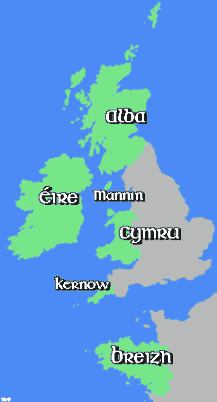OBER correspondence courses were created in 1932 by Marc'harid Gourlaouen (1902-1987).
Since then, thanks to these courses, thousands of people have been able to learn, improve, or simply get the basics of the Breton language.
Breton is a Celtic language, with Indo-European roots
Modern Celtic languages are:
Gaelic branch:
Breton branch:
|
Language and History
Breton is derived from Indo-European languages
Like the Germans, Latins, Greeks, Slavs, Persians and the inhabitants of northern India, the Celts spoke a language derived from an older common language called Indo-European, named so because of the extent of its geographical spread. Sanskrit represents perhaps the language being the closest to it.
This language, spoken 4000 years ago, and which has no written text, had spread over the centuries into almost every area of Europe and to the border regions of India imposing itself gradually, through random wars, invasions and commerce on a wide variety of peoples and populations.
Breton is a Celtic language
One Indo-European population, probably established in the territory between the Rhine, Danube and Main, distinguished itself some 3000 years ago by its economic activity and its art. These people were called Keltae by the Greeks and Galli by the Romans. They then sprad to occupy all of northern Europe, and began to mix with the local populations. It is from this mixture that emerged those that we know of today as the Celtic peoples (Celts). They brought their culture and their language, which we call "Old Celtic", to a large part of Europe, stretching from Ireland to the tip of the Iberian peninsula and the Black Sea.
This Celtic world was to decline and be absorbed under pressure from the Germans in the north and the Latins in the south. The celtic language of continental Europe continued to decline and eventually died out in the valleys of Helvetia around the year 1000 A.D. However, it remained alive in the British Isles, home to two Celtic peoples, the Britons and the Gaels, who spoke two different forms of the celtic language. The language of the Gaels developed into Irish Gaelic, Scottish Gaelic and Manx (the Isle of Man) and from that of the Britons (Brythonic) came Breton, Cornish and Welsh.
From fifth to seventh century, Britons of the island of Britain, were driven by the invading Anglo-Saxons to migrate in large numbers to the Armorican peninsula.
In general terms, the history of the Breton language can be divided into three stages :
The Breton of the kings
Before the year 1000, the era of Old Breton emerged, Nominoe Breton emerged after a gradual development of the language from the merging of Briton emigrants and Armoricain Celts on the peninsula.
In the ninth century, Nominoe's reign marks the apex of the Breton nation and the furthest advances in the language. Breton spread to the east, becoming dominant in the Rennes and Nantes areas. Around 1050, it reached its phase of maximum expansion, being spoken as far as Mont Saint Michael bay and the Saint-Nazaire region.
At this time the language was still close that spoken in parts of Britain, especially Cornish but also Welsh, a language almost purely Celtic apart from some old borrowings from Latin, a vestige of the Roman occupation of Britain, now perfectly assimilated. It was a symbol of the Breton nation, an independent kingdom and purely Celtic, although still retaining within its borders regions where non-celtic peoples still spoke dying romance dialects derived from Latin. Breton was the language of the majority of the population and of the ruling classes, the language and culture and of law, as was the Welsh of Hywell Dda, the language of the active members of the nation.
This was when place names and peoples surnames were established in Breton.
The Breton of the dukes
This is when Middle Breton emerged, from 1000 A.D. to the seventeenth century. This period dates from the great Norman invasion which changed the face of the land.
The norman invasions had an negative effect on the unity of Brittany. The Breton language was abandoned as the official language by the Duchy of Brittany at the height of the Middle Ages in favour of French. Breton retreated gradually towards the west.
The ruling classes, nobles and monks who had to flee the country returned after thirty years exile influenced seriously by the French language.
Brittany remained a sovereign state, separate from both France and England but its official language, that of the Court and the Administration, became French, followed gradually by the language of the bourgeoisie.
However, Breton continued to be the usual language spoken by the ordinary people and nobility of rural areas and small towns and remained a literary language, but it was to undergo an evolution similar to the one English underwent during the same period.
Eventhough its syntax remained very Celtic, it was to come under a strong influence from French, especially in its vocabulary and the way it was written.
If Breton had become the official language of the Duchy at that time, it is likely that it would have kept this hybrid Celto-romance from in the way that English became a Germanic-romance language rather than purely Germanic. This form of Breton corresponds to the ducale period but continued after the loss of independence and the disappearance of our state. Parts of the state structure remained during the period of autonomy which ended with the French Revolution, however, the ruling classes continued to abandon their language to switch to French. It should be noted that Middle Breton is a literary and unified language, not the language of the people. Dialects existed, of course, but not in the written form.
The modern Breton
It is in the mid seventeenth century, in 1659 to be precise, that a revolution took place with the adoption by Father Maunoir of a way of writing that was much closer a to the spoken language, and, which records for the first time the mutation of consonants, and, at the same time, breaks with the ancient literary tradition, most notably with the system of prosodic Celtic alliteration and internal rhyming similar to those to be found in Welsh and Irish Gaelic, and whose roots go back to the distant past, before the division of the former Brythonic into distinct different languages. Breton was to become primarily a language of the people.
The consequence of adopting this system was to be the break-down of the unity of the language and henceforth people tended to write the language in the way that it was spoken in their region. This led to the development of the different literary dialects of expression giving rise to the modern-day dialects of Leonad, Tregorois, Cornouaillais, and Vannetais.
However, this return to the living spoken language as a basis, which was often more Celtic in its structure and also in its vocabulary than the written Middle Breton, served as a rejuvenation.
The grammarians and writers of the nineteenth century (The Gonidec), and then of the twentieth century (Ernault, Vallée, Mordiern) would try and regain this lost unity by, on the one hand, basing Breton on the form spoken mainly in the Leon region (Leonard), and on the other hand, by building on the efforts already undertaken in the eighteenth century by Dom Le Pelletier, in trying to eliminate from the language the excessive borrowings of French that had occured in the previous centuries and by replacing these and expanding the language by drawing on ancient Breton, the dialects and Welsh to provide new words having Breton roots.
They would go on to gradually build a new literary from of the language which is clearly Celtic in style. This is Modern Breton, albeit with a significant number of words of French or Latin Origin, but as a language relatively "pure" and not an hybrid such as Middle Breton or French.
The Breton language, systematically persecuted since the time of the French Revolution, has managed however to survive. Today, although the use of Breton is declining in the countryside, it is becoming a language of culture, adapted to the urban civilization of the twenty-first century.
The language has been revitalized by the teaching of Breton in universities, in the Diwan schools where Breton is medium for teaching, in the bilingual Divyezh state schools, and in the private sector Dihun schools, and also by the willingness of brittophones to speak their language on a daily basis. Some radio and TV stations do offer programmes in Breton but to date there is, despite strong demand, no public Breton radio or television in Brittany. However, there are newspapers, magazines and publishing houses as well as theatre groups. The Office of the Breton Language, created in 1999, implements actions for the promotion and development of the language in social and public life. It is worth noting that France has still not ratified the European Charter for Minority Languages in 2008.
The number of brittophones is now estimated to be 350 000.

